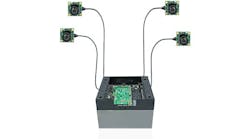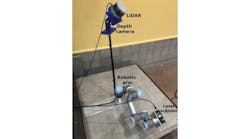Barcodes on drug labels is a good idea—even better, put a barcode on every pill.
by Andy Wilson
EDITOR
[email protected]
In February 2004, Health and Human Services (HSS) Secretary Tommy Thompson announced that the US Food and Drug Administration (FDA; Rockville MD, USA; www.fda.gov) would require barcodes on labels of thousands of drugs to protect patients from preventable medication errors and reduce costs of health care. The FDA's rule calls for linear barcodes on most prescription-drug packages and certain over-the-counter drug packages used in hospitals. Each barcode will contain a drug's National Drug Code number, strength, and dosage, encoded within a label on the product.
Certainly, the FDA is to be commended for forcing this measure upon possibly reluctant pharmaceutical companies. The barcode rule will encourage adoption of systems that, in some hospitals, have already reduced medication-error rates by as much as 85%.
Dividends for scanner manufacturers and barcode companies may, however, be years away. According to WincoID (Nashua, NH, USA; www.wincoid.com), the FDA's standard will not be issued until late this year and will not become effective until three years after it is finalized. Estimated implementation costs will be $50 million for pharmaceutical companies to add barcodes to packages and $7.2 billion for the health-care industry to implement barcode readers.
Although barcode and scanner manufacturers may reap benefits, insurance companies are sure to increase their premiums when they receive invoices from the drug companies. But, argues the FDA, the rule, when fully implemented, will help prevent nearly 500,000 "adverse events" and transfusion errors over 20 years. Economic benefits of reducing health-care costs, patient pain and suffering, and lost work time due to possible adverse events are estimated to be $93 billion over the same period. Anyone good at mathematics will realize the amortization period for the plan will be approximately 15 years.
Despite the cost, many expect hospitals and pharmaceutical companies to add barcodes sooner than required. Today, 35% of drugs given to hospital patients are packaged with barcodes. Companies such as Pfizer (New York, NY, USA; www.pfizer.com) already print barcode information on individual pill packages used in hospitals. Before the end of the year, Pfizer aims to identify names, dosages, lot numbers, and expiration dates of all 30 medicines it supplies for hospital use with a barcode on each pack. Abbott Labs (Abbott Park, IL, USA; www.abbott.com) also has a barcode program for individual units of intravenous solutions and injection drugs. Abbott says it is 90% of the way toward introducing new labeling, but barcodes will not include expiration date or lot numbers.
While the FDA rule will reduce heath-care costs, it should only be the beginning of a roadmap designed to ensure the proper use of prescription drugs. For example, according to the US Department of Health and Human Services report, 1997Monitoring the Future Study, there is increased use of Ketamine (or "Special K") in many cities, including Miami, New York, Baltimore, New Orleans, and Detroit. Because of its anesthetic properties, the prescription drug is considered to be one of the "date-rape" drugs. Although rare, several fatal overdoses have been reported from just this one drug.
To reduce the number of casualties of such drugs, the FDA should consider demanding barcoding every tablet or drug with a 2-D matrix code indicating its National Drug Code number, strength, dosage, expiration date, lot number, place of origin of manufacture, and the targeted pharmacy location. In this way, law-enforcement officials could better crack down on those responsible for illegally trafficking prescription drugs. Although it may cost more to print 2-D data-matrix codes on every tablet, the consequences will be more than justified by a reduction in drug-overdose fatalities.




